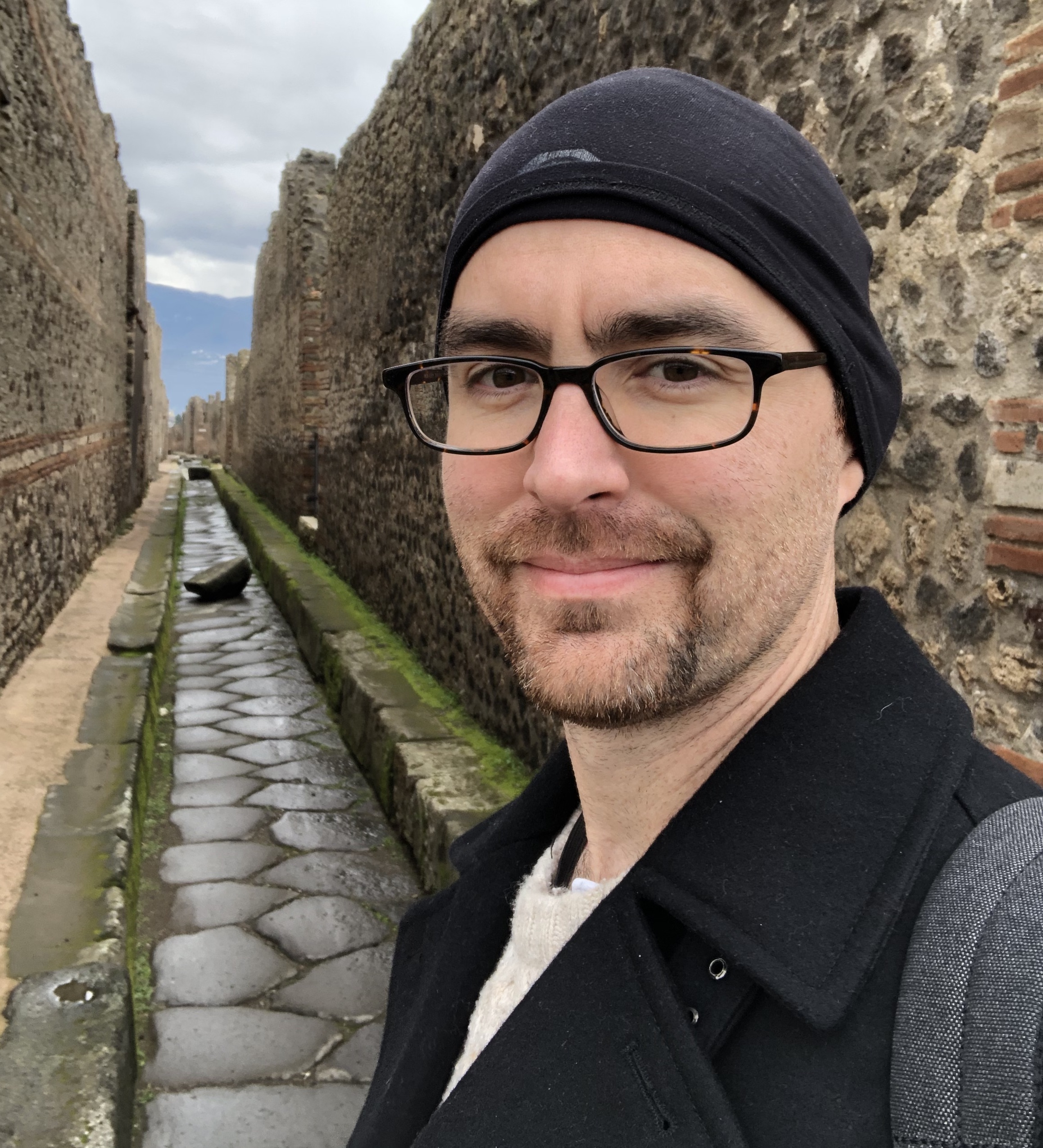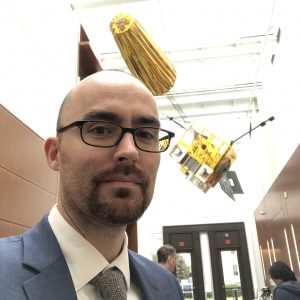Researcher Spotlight: Devin Schrader
Get to know Center researchers with this periodic feature!
Dr. Devin Schrader is the Interim Director of the ASU Center for Meteorite Studies (CMS) and an Associate Professor in the School of Earth and Space Exploration (SESE). His research focuses on the study of primitive meteorites th at have remained relatively unaltered since they formed in the early Solar System ~4.5 billion years ago. He also works on samples returned from asteroids, including those returned from asteroid Itokawa by the Japanese Space Agency (JAXA), and is a collaborator on NASA’s OSIRIS-REx asteroid sample return mission.
at have remained relatively unaltered since they formed in the early Solar System ~4.5 billion years ago. He also works on samples returned from asteroids, including those returned from asteroid Itokawa by the Japanese Space Agency (JAXA), and is a collaborator on NASA’s OSIRIS-REx asteroid sample return mission.
 at have remained relatively unaltered since they formed in the early Solar System ~4.5 billion years ago. He also works on samples returned from asteroids, including those returned from asteroid Itokawa by the Japanese Space Agency (JAXA), and is a collaborator on NASA’s OSIRIS-REx asteroid sample return mission.
at have remained relatively unaltered since they formed in the early Solar System ~4.5 billion years ago. He also works on samples returned from asteroids, including those returned from asteroid Itokawa by the Japanese Space Agency (JAXA), and is a collaborator on NASA’s OSIRIS-REx asteroid sample return mission.
Schrader, a native to Arizona, grew up in the boondocks where the night skies were clear and the constellations were rarely obscured.
Photo: D. Schrader.
That led to an interest in stars and a love of astronomy. I had a telescope as a kid and would spend hours on the garage roof with it, staring into space. But it wasn’t until grade school, when I was about 12 or 13 years old, that I realized you could hold space rocks in your hand. I was fascinated.
Schrader’s fascination with meteorites led him to become a regular visitor to the world-renowned Tucson Gem and Mineral show (held every February in Tucson, Arizona) where he had the chance to see an incredible array of meteorites. Meanwhile, the University of Arizona’s (UA) reputation for astronomy research enticed him to become a Wild Cat while he pursued a double major in Physics and Astronomy.
I loved astronomy and thought I wanted to be an astronomer. I was fascinated by meteorites but I didn’t know that studying them was an actual career until I did a NASA Space Grant internship classifying meteorites. That made me realize that I could apply my physics and astronomy background to the study of meteorites.
Following rewarding and fascinating internships with both Prof. Dante Lauretta (PI of the OSIRIS-REx asteroid sample return mission) at UA and Prof. Harold Connolly Jr. at the American Museum of Natural History, Schrader stayed at UA for graduate school and worked with both Dante and Harold.
During grad school, I had the opportunity to work with primitive meteorites, specifically CR chondrites, which represent the earliest stages of our solar system’s history. If you want to understand why our solar system looks like it does today, you have to understand what it formed from. These 4.5 billion year old rocks give us the best opportunity to do that.
After graduating with a Ph.D. in 2012, Schrader became a postdoctoral fellow at the University of Hawaiʻi at Mānoa and then the Smithsonian’s National Museum of Natural History. Schrader worked with Dr. Tim McCoy, the Smithsonian’s Curator of Meteorites; together they provided sample science support for the OSIRIS-REx asteroid sample return mission.
Working with Tim was a dream come true. He’s a leader in his field and I learned a lot from him. Tim encouraged me to diversify and work on a whole range of other meteorite types, including primitive achondrites. We also worked on the OSIRIS-REx mission together – that was a lot of fun. It’s been amazing to watch the mission progress and I can’t wait to see the samples return from asteroid Bennu in 2023.
Schrader became a Sun Devil in Summer 2015, when he joined the Center for Meteorite Studies as Assistant Director and Assistant Research Professor; he is now the Interim Director of CMS and an Associate Research Professor.
The Center for Meteorite Studies at ASU is an amazing place to work. In the vault, we have meteorites that represent every stage of Solar System history. It’s a researcher’s dream. And we’re ideally situated to interact with the local community through events in the School for Space and Earth Exploration.
 Currently, Schrader is focused on using isotopic and compositional analyses to determine the chemistry of the protoplanetary disk and trace migration of material in the early Solar System. This recently led Schrader to analyze grains returned from asteroid Itokawa by the Hayabusa mission and he hopes to analyze more returned samples in the coming years.
Currently, Schrader is focused on using isotopic and compositional analyses to determine the chemistry of the protoplanetary disk and trace migration of material in the early Solar System. This recently led Schrader to analyze grains returned from asteroid Itokawa by the Hayabusa mission and he hopes to analyze more returned samples in the coming years.
For his contributions to planetary science and the OSIRIS-REx mission, Schrader has an asteroid named after him; you can find his name sake, Asteroid 117581 Devinschrader (2005 EG37), in the asteroid belt.
Learn more about Dr. Schrader’s research here: https://meteoriticist.com/
Watch a tour of the Meteorite Vault by Dr. Schrader and Dr. Davidson here: https://meteorites.asu.edu/collection
In the news:
Fragments of asteroids may have jumped the gap in the early solar system https://meteorites.asu.edu/news/gap
New paper on cosmochemistry advances from Antarctic meteorites! https://meteorites.asu.edu/news/antmet
Acapulcoite-lodranite meteorite group https://meteorites.asu.edu/news/aclo-paper
CR chondrite metamorphism https://meteorites.asu.edu/news/cr-met
Background temperature of the protoplanetary disk https://meteorites.asu.edu/news/new-paper
Recent publications:
Schrader D. L., Nagashima K., Davidson J., McCoy T. J., Ogliore R. C., and Fu R. R. (2020) Outward migration of chondrule fragments in the Early Solar System: O-isotopic evidence for rocky material crossing the Jupiter Gap? Geochim. Cosmochim. Acta 282, 133–155.
Fu R. R., Kehayias P., Weiss B. P., Schrader D. L., Bai X.-N., and Simon J. B. (2020) Weak magnetic fields in the outer solar nebula recorded in CR chondrites. Journal of Geophysical Research: Planets 125, e2019JE006260.
Wadhwa M., McCoy T. J., and Schrader D. L. (2020) Advances in cosmochemistry enabled by Antarctic meteorites. Annual Review in Planetary Science 48, 233–258.
Davidson J., Schrader D. L., Alexander C. M. O’D., Nittler L. R., and Bowden R. (2019) Re-examining thermal metamorphism of the Renazzo-like (CR) carbonaceous chondrites: Insights from pristine Miller Range 090657 and shock-heated Graves Nunataks 06100. Geochimica et Cosmochimica Acta 267: 240–256.
McCoy T. J., Corrigan C. M., Dickinson T. L., Benedix G. K., Schrader D. L., and Davidson J. (2019) Grove Mountains (GRV) 020043: Insights into acapulcoite-lodranite genesis from the most primitive member. Geochemistry 79(4): 125536.
Written by
Dr. Jemma Davidson
Assistant Research Scientist
Center for Meteorite Studies
School of Earth and Space Exploration
Arizona State University